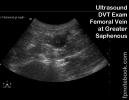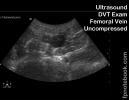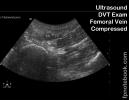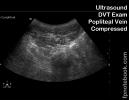Focused Lower Extremity Venous Ultrasound, Venous Doppler Ultrasound of Lower Extremity, DVT Ultrasound, Limited Assessment of Lower Extremity Venous System for Deep Vein Thrombosis, Lower Extremity Doppler Ultrasound, Limited Compression Ultrasound for DVT, Compression Ultrasonography for DVT, Compression Ultrasound for DVT, Compression Sonography for DVT, Two Point DVT Ultrasound, DVT POCUS
- See Also
- Protocol
- Two Point DVT Ultrasound
- Interpretation
- Positive Focused Ultrasound
- Anticoagulate and arrange for formal comprehensive venous Ultrasound
- Negative Focused Ultrasound
- See Wells Clinical Prediction Rule for DVT
- DVT unlikely (Modified Wells Score <2)
- No further DVT testing needed
- DVT higher likelihood (Modified Wells Score >=2)
- D-Dimer negative
- No further DVT testing needed
- D-Dimer positive
- Arrange for formal comprehensive venous Ultrasound
- Anticoagulate if any significant delay in obtaining formal Ultrasound
- D-Dimer negative
- Positive Focused Ultrasound
- Precautions
- Wells Clinical Prediction Rule for DVT has wide discordance among providers (19% in this study)
- Two point Ultrasound does not assess for calf DVT
- References
- Imaging
- Two Point Focused Exam (by ER provider)
- Precautions
- This technique does not identify calf DVT
- Full venous Ultrasonography should be performed in all inconclusive cases with moderate to high suspicion
- Pearls
- In obese patients, compress untill artery starts to collapse
- Transducer
- Linear Array Transducer (5-12 MHz)
- Positioning
- Raise head of bed to 30-45 degrees
- Externally rotate leg
- Consider dropping leg over side of bed to help engorge veins
- Expose thigh and popliteal fossa
- Protocol evaluates vein compressibility and intravenous clot at a minimum of 3 waypoints
- Common Femoral Vein (near inguinal crease)
- Common Femoral Vein at confluence of greater saphenous vein
- Ideally perform compression at anterior thigh waypoints every 2 cm distally until unable to visualize
- Popliteal Vein (posterior to knee)
- Images
- Start position: Proximal Thigh
- Immediately below inguinal ligament
- Transducer is transverse (in short axis)
- Common Femoral Vein starts medial to femoral artery
- Moving distally, common femoral vein lies deep (posterior) to femoral artery
- Technique: Anterior upper leg
- Move distally down the course of the femoral vein in 1 cm increments (for 5-10 cm length)
- Greater saphenous vein will intersect the common femoral vein within a few centimeters of the inguinal ligament
- Femoral vein will become more difficult to visualize as the medial knee is approached
- Examiner may place opposite hand beneath the distal-medial thigh to improve visability
- Continue anterior examination until just below the bifurcation into superficial and deep femoral veins
- At each femoral vein cross section (with femoral artery in the same view)
- Demonstrate that the femoral vein can be fully compressed
- Only accurate if compression is 90 degrees to the vessel (vessel may not compress with oblique pressure)
- Non-compressible vein suggests DVT
- Echogenic material may be seen within the vessel in a DVT present at least 5 days
- Consider using dual screen, one side with uncompressed vein and the other with compression
- Document with a continuous video or frozen images
- Demonstrate that the femoral vein can be fully compressed
- Move distally down the course of the femoral vein in 1 cm increments (for 5-10 cm length)
- Technique: Posterior leg from popliteal space inferiorly
- Identify the popliteal artery and vein in the popliteal space
- Continue to compress and release pressure on the popliteal vein for several centimeters below the popliteal space
- Technique: Augmentation (distal and proximal) - Optional
- Venous flow normally varies with respiration
- Augmentation of venous flow normally occurs when the calf is compressed and released or the Abdomen is compressed
- Visualize flow variation with color doppler (best seen when the vein is viewed longitudinally)
- Vein with DVT will lose its respiratory variation in flow and the augmentation effect with distal and proximal augmentation
- Iliac DVT (e.g. pregnancy) may be identified if femoral vein fails to vary in flow with respiration (may indicate Pelvis CTA)
- Calf thrombus may be identified on distal calf compression due to lack of augmentation (may indicate follow-up exam or calf Ultrasound)
- Documentation: Document fully compressible vein at two levels minimum
- Proximal femoral vein (with greater saphenous branch visualized)
- Popliteal vein
- Efficacy
- DVT diagnosis by standard Compression Ultrasonography (by experienced Ultrasound tech)
- Symptomatic patient with unilateral proximal lower extremity swelling
- Test Sensitivity: 89-96%
- Test Specificity: 94-99%
-
False Negatives
- Test Sensitivity falls to <50% for asymptomatic proximal DVT
- False Negatives also seen with calf DVT, Upper Extremity DVT or pelvic vein thrombosis
- Efficacy
- Emergency and Primary Care Providers
- Accuracy improves to nearly 100% when Ultrasounds are repeated (typically at 1 week, esp. calf DVT)
- Focused two point, Point of Care Ultrasound (femoral, popliteal)
- Emergency Providers
- Primary Care Providers
- Resources
- Limited Assessment of Lower Extremity Venous System for Deep Vein Thrombosis (DVT) Video
- How to: Lower Extremity Deep Vein Thrombosis with Ultrasound (Sonosite)
- Advantages
- Can be done in the office setting
- Ultrasound is highly sensitive for deep vein thrombi
- Disadvantages
- Ultrasound is not sensitive for detecting thrombi in calves
- References
- Derr (2012) Introduction and Advanced Emergency Medicine Ultrasound Conference, GulfCoast Ultrasound, St. Pete's Beach
- Reardon (2013) Emergency Ultrasound Course, 3rd Rock Ultrasound, Minneapolis, MN
- Noble (2011) Emergency and Critical CareUltrasound, Cambridge University Press, New York, p. 173-89
- Reardon (2011) Pocket Atlas Emergency Ultrasound, McGraw Hill, New York, p. 239-58





